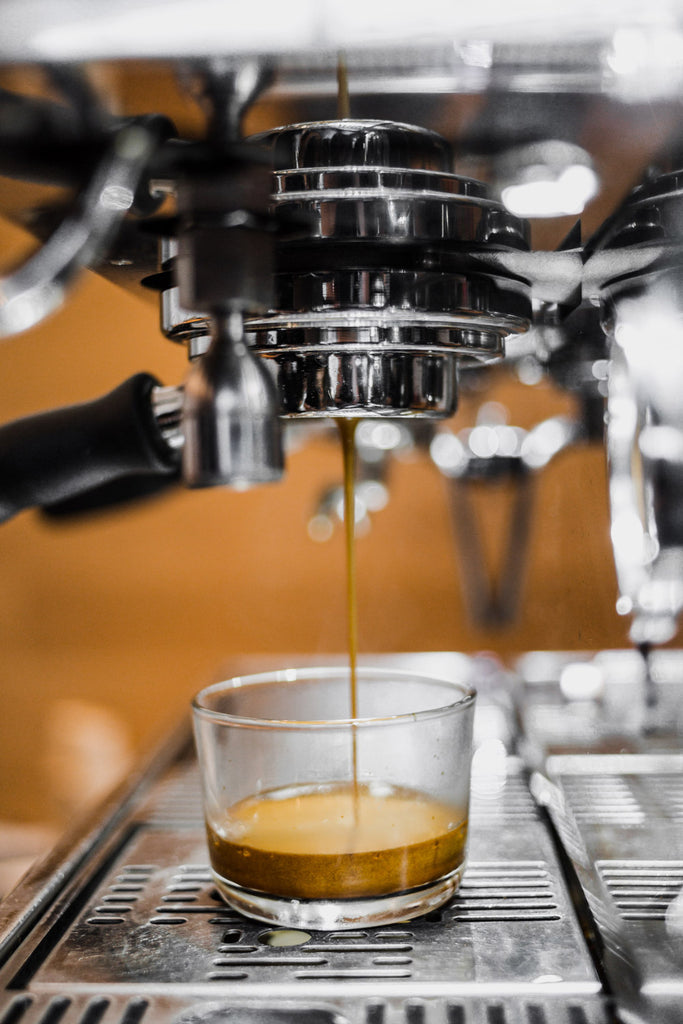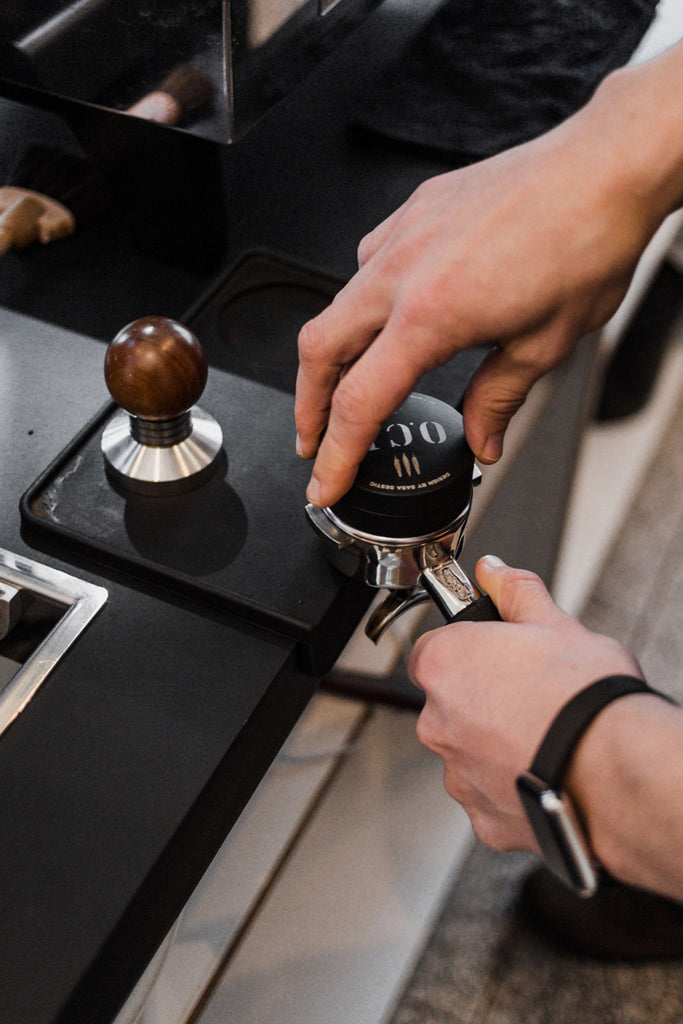In the world of coffee, many elements come together in perfect symbiosis, creating an almost endless variety of aromas. The preparation of an espresso, in particular, combines outstanding engineering with exquisite craftsmanship. But does the perfect espresso "only" require a professional espresso machine and high-quality beans? Of course, these factors are essential, but proper tamping is the key to the secret. Therefore, this week we'll show you the basics of proper tamping, why it's so important, which tampers are best suited, and which mistakes you should avoid. Enjoy reading!
Proper tamping - The basics
Tamping primarily involves firmly pressing the coffee grounds into the portafilter. However, it's a bit more complicated than it might sound – more on that later. Proper tamping ensures the coffee grounds are evenly distributed, guaranteeing optimal extraction of the aromas.
Choosing the right tamper:
There's a huge selection of tampers available – from stainless steel to elegant wood or modern aluminum. The right tamper becomes, metaphorically speaking, an extension of the barista's arm and contributes significantly to making the perfect espresso. In Germany, hand tampers are predominantly used. When choosing a tamper, make sure its size matches the size of your portafilter. No matter how good-looking the tamper is, if it doesn't perform as intended, it's unfortunately useless. Tip: Most standard models have a diameter of 58mm. The smaller the tolerance, the better your tamping will be.
Lever tampers are also commonly used abroad. These mechanically compress the coffee grounds and are often already integrated into portafilter machines.

Why is proper tamping so important?
Proper tamping plays a crucial role in extracting aromas from the coffee grounds. Uneven distribution or excessive pressure can prevent the hot water from being forced evenly through the coffee, resulting in a watery espresso or one that is over-extracted and tastes bitter. Why does this happen? Water is "lazy" and takes the path of least resistance. This process is also known as channeling. Therefore, proper and, above all, even tamping is of great importance when preparing an espresso.
Instructions for proper tamping:
-
The correct amount of coffee powder:
The correct dosage is essential for proper tamping. Only with the right amount can you firmly press the grounds into the portafilter without having to worry about air pockets or coffee grounds overflowing.
-
The correct distribution of coffee grounds:
Here you can simply use your eye and a gentle tap against your hand to distribute the grounds. If you prefer to use professional equipment, you can use a coffee grounds distributor (needle distributor). This will ensure the grounds are evenly distributed in the portafilter.
-
The actual tamping:
Press the tamper onto the coffee grounds with light, even pressure. This ensures even compaction.
-
Correctly inserting the portafilter:
To prevent the compressed coffee grounds from loosening again, you must insert the portafilter parallel to the machine. It shouldn't be too tight here either, as this could create grooves through which the water could seep.
As you can see, tamping is not just a mechanical action, but also a sensory experience, as the barista feels the resistance of the coffee grounds in the portafilter and can hear the grinding of the grounds as they are pressed. These subtle processes are crucial for the taste of the espresso.

You should definitely avoid these mistakes.
-
Once common practice - now frowned upon:
Never strike the tamper against the portafilter to distribute any loose coffee grounds onto the already tamped coffee. This will loosen the entire coffee puck and increase the risk of channeling.
-
How to tamp correctly without twisting
When tamping the coffee grounds, only press down and don't rotate the tamper while doing so. Otherwise, you'll tear the surface again, and your efforts will have been for nothing. At the end, you can rotate the tamper completely without pressure. This will make the surface even more even. But really, without any pressure!
In summary, this seemingly insignificant step in the preparation of an espresso is more than just necessary. Without proper tamping, the espresso will be watery or over-extracted, making it not only undrinkable, but also a waste of coffee grounds. So invest in a good, final tamper that fits your espresso machine. We'd be happy to advise you in one of our stores.
Your SIMON&BEARNS Team


Proper tamping - here's how it works
In the world of coffee, many elements come together in perfect symbiosis, creating an almost endless variety of aromas. The preparation of an espresso, in particular, combines outstanding engineering with exquisite craftsmanship. But does the perfect espresso "only" require a professional espresso machine and high-quality beans? Of course, these factors are essential, but proper tamping is the key to the secret. Therefore, this week we'll show you the basics of proper tamping, why it's so important, which tampers are best suited, and which mistakes you should avoid. Enjoy reading!
Proper tamping - The basics
Tamping primarily involves firmly pressing the coffee grounds into the portafilter. However, it's a bit more complicated than it might sound – more on that later. Proper tamping ensures the coffee grounds are evenly distributed, guaranteeing optimal extraction of the aromas.
Choosing the right tamper:
There's a huge selection of tampers available – from stainless steel to elegant wood or modern aluminum. The right tamper becomes, metaphorically speaking, an extension of the barista's arm and contributes significantly to making the perfect espresso. In Germany, hand tampers are predominantly used. When choosing a tamper, make sure its size matches the size of your portafilter. No matter how good-looking the tamper is, if it doesn't perform as intended, it's unfortunately useless. Tip: Most standard models have a diameter of 58mm. The smaller the tolerance, the better your tamping will be.
Lever tampers are also commonly used abroad. These mechanically compress the coffee grounds and are often already integrated into portafilter machines.
Why is proper tamping so important?
Proper tamping plays a crucial role in extracting aromas from the coffee grounds. Uneven distribution or excessive pressure can prevent the hot water from being forced evenly through the coffee, resulting in a watery espresso or one that is over-extracted and tastes bitter. Why does this happen? Water is "lazy" and takes the path of least resistance. This process is also known as channeling. Therefore, proper and, above all, even tamping is of great importance when preparing an espresso.
Instructions for proper tamping:
The correct dosage is essential for proper tamping. Only with the right amount can you firmly press the grounds into the portafilter without having to worry about air pockets or coffee grounds overflowing.
Here you can simply use your eye and a gentle tap against your hand to distribute the grounds. If you prefer to use professional equipment, you can use a coffee grounds distributor (needle distributor). This will ensure the grounds are evenly distributed in the portafilter.
Press the tamper onto the coffee grounds with light, even pressure. This ensures even compaction.
To prevent the compressed coffee grounds from loosening again, you must insert the portafilter parallel to the machine. It shouldn't be too tight here either, as this could create grooves through which the water could seep.
As you can see, tamping is not just a mechanical action, but also a sensory experience, as the barista feels the resistance of the coffee grounds in the portafilter and can hear the grinding of the grounds as they are pressed. These subtle processes are crucial for the taste of the espresso.
You should definitely avoid these mistakes.
Never strike the tamper against the portafilter to distribute any loose coffee grounds onto the already tamped coffee. This will loosen the entire coffee puck and increase the risk of channeling.
When tamping the coffee grounds, only press down and don't rotate the tamper while doing so. Otherwise, you'll tear the surface again, and your efforts will have been for nothing. At the end, you can rotate the tamper completely without pressure. This will make the surface even more even. But really, without any pressure!
In summary, this seemingly insignificant step in the preparation of an espresso is more than just necessary. Without proper tamping, the espresso will be watery or over-extracted, making it not only undrinkable, but also a waste of coffee grounds. So invest in a good, final tamper that fits your espresso machine. We'd be happy to advise you in one of our stores.
Your SIMON&BEARNS Team